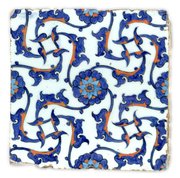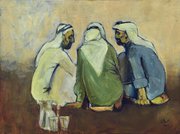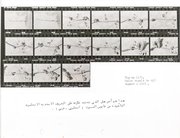
Nasrid Woven Silk Curtain
Museum of Islamic Art
- Title:
- Nasrid Woven Silk Curtain
- Production place:
- Granada
- Date:
- 1354 - 1391
- Period:
- Nasrid
- Title:
- Nasrid Woven Silk Curtain
- Production place:
- Granada
- Date:
- 1354 - 1391
- Period:
- Nasrid
- Material:
- Silk
- Technique:
- Weaving
- Dimensions:
- 386 × 270 cm
This textile, made of six pieces sewn together, is one example of the silk curtains described in the Mexuar of Muhammad V (r. 755-761 and 764-794 AH/1354-1359 and 1362-1391 CE) by the medieval historian Ibn al-Khatib, who visited the Alhambra palace in 794 AH/1362 CE. The design includes recalls stucco and tilework ornaments, especially those of the Palacio de Los Leones, as well as the textile metaphors inscribed on the walls of the palace. Featuring predominantly yellow on a red background with a few blue or white sections, the curtain is composed of two symmetrical fields organized in squares and divided by a vertical frieze with two horizontal bands at the bottom and top parts. The overall design includes indented merlons, interlocked chainmail motifs, stylized vegetal designs, rosettes and mirror reverse Arabic inscriptions emblematic of the Nasrid mottos using Kufic and thuluth scripts. The weaving technique is typical of the late 8th century AH/14th-century CE, when weavers would substitute gold with yellow silk threads, similarly to the replacement of gilt paint with yellow pigments in manuscripts. The use of mirrored calligraphy and the strict geometry of such panels show that weavers would have worked by pair with a thread model (naqsha), elaborated by a court artist (naqshband) who created drawings tied to the loom. We could presume the existence of different workshops working at the same time with several naqshbands trained on the same type of motifs. Three textiles in other collections are indicative of the very similar yet unidentical manufacture (the Metropolitan Museum of Art inv. 29.22; Cleveland Museum of Art, inv. 82.16; Cooper Hewitt Museum, inv. 1902-1-304).



